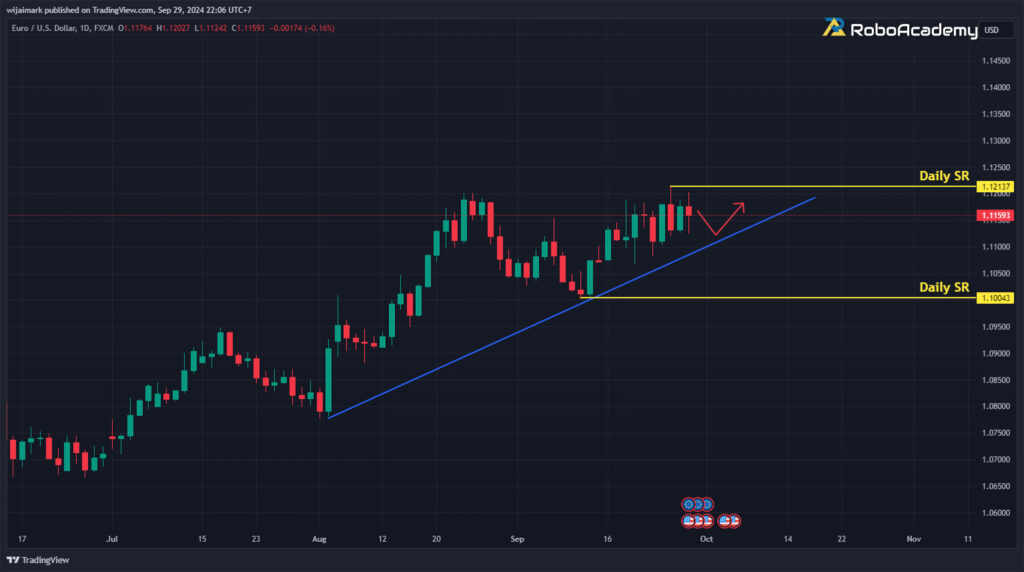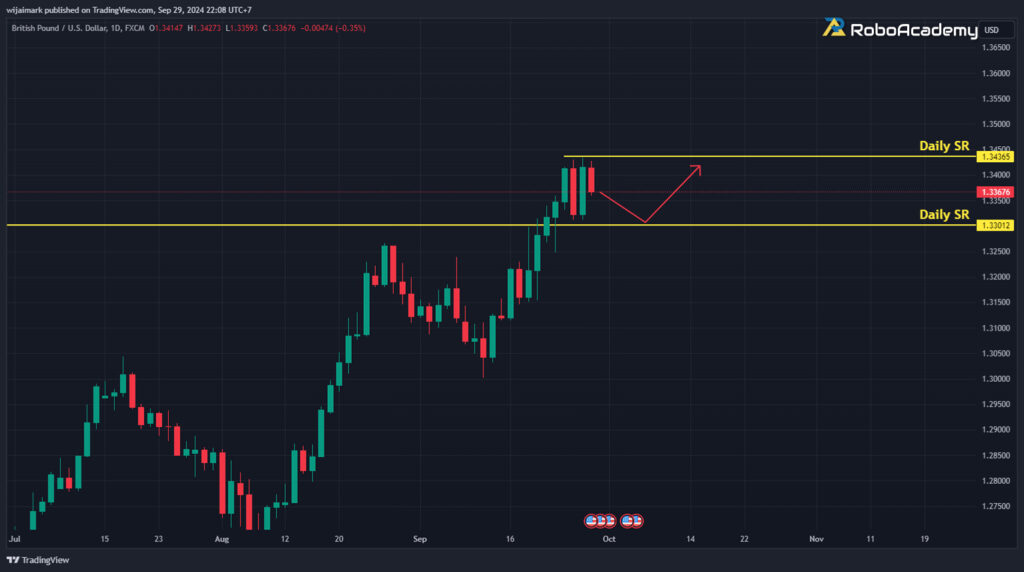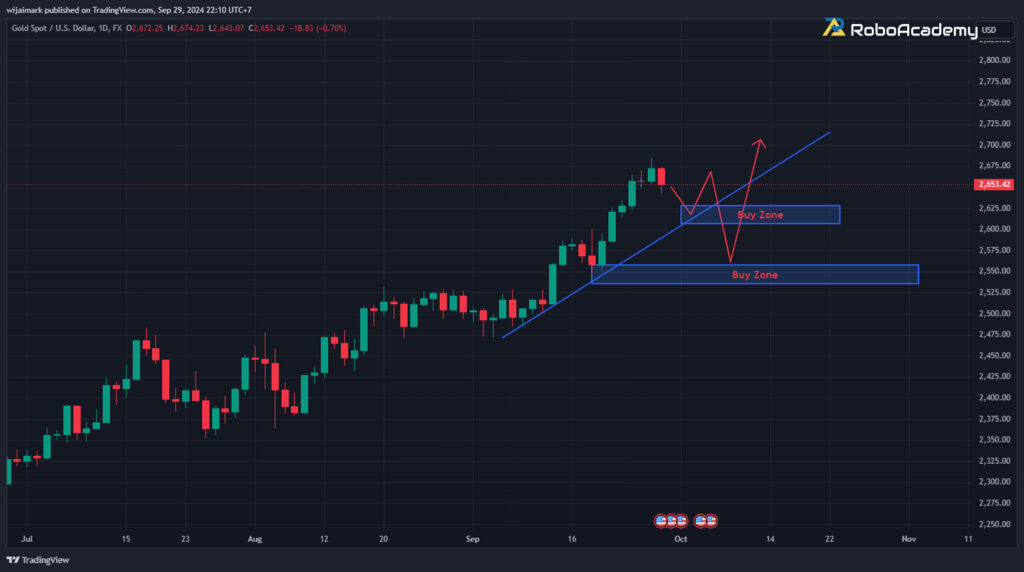Fundamental & Technical Analysis by Coach Mark RoboAcademy during 30 September – 4 October 2024
Hello everyone, welcome to the weekly analysis of currency pairs EUR/USD, GBP/USD, and XAU/USD for the last week of September and the first week of October, from 30 September – 4 October 2024.
EUR/USD, “Euro vs US Dollar”

Fundamental Analysis
Significant Economic Events Impacting EUR/USD This Week:
European Economic Data:
- Eurozone CPI Index (September 30): The announcement of Eurozone inflation will be very significant. If the CPI index rises, it could increase pressure on the European Central Bank (ECB) to tighten monetary policy, which may lead to an appreciation of the euro.
- Germany Retail Sales (October 2): This figure reflects the economic conditions and consumer spending within Germany, the largest economy in the Eurozone. If retail sales exceed expectations, the euro could gain support from increased confidence in the economy.
- European Central Bank (ECB) Meeting (October 3): While no new policy announcements are expected, any statements or comments from the ECB regarding inflation and growth could affect the market. If there are signals of future interest rate adjustments, the euro may strengthen.
U.S. Economic Data:
- ISM Manufacturing PMI (October 2): This figure reflects the economic activity in the U.S. manufacturing sector. If the data is strong, the U.S. dollar may appreciate as the market believes the U.S. economy remains robust.
- Non-Farm Payrolls (October 4): The employment figures will act as an indicator of the strength of the U.S. labor market. If employment data is strong, the dollar is likely to gain support, as the market anticipates the Federal Reserve may maintain a tight monetary policy to mitigate inflation risks.
Technical Analysis
The price is currently testing a key resistance zone at 1.12100, which it has not yet been able to break through. This suggests the possibility of a slight pullback this week. It is essential to be extra cautious as the Non-Farm Payroll (NFP) report will be released on Friday, October 4th, which could cause market volatility. If you plan to trade, waiting to buy around the trendline near 1.10000 in anticipation of a potential price rebound that could break through the resistance is also a viable strategy.
GBP/USD, “Great Britain Pound vs US Dollar”

Fundamental Analysis
Significant Economic Events Impacting GBP/USD This Week:
U.K. Economic Data:
- UK Consumer Price Index (CPI) (September 30): If inflation in the UK remains high, it could lead the Bank of England (BoE) to maintain a hawkish stance on monetary policy, which may support the strengthening of the pound.
- Manufacturing PMI (October 2): This report will reflect the state of the UK’s manufacturing sector. If the data comes out better than expected, the pound could gain support from increased economic confidence.
- Bank of England (BoE) Meeting (October 3): The BoE’s statement on monetary policy will impact the pound. The pound could appreciate if the bank signals further interest rate hikes to combat inflation.
U.S. Economic Data:
- Non-Farm Payrolls (October 4): This figure will be a key indicator in assessing the health of the U.S. economy. If employment data is strong, the U.S. dollar is likely to strengthen, which may lead to a depreciation of the pound when compared to the dollar.
Technical Analysis
The price has broken through the previous resistance at 1.33000 and is now facing new resistance at 1.34350. It is recommended to use trading techniques within this price range, potentially considering a Buy when the price dips, in anticipation of the price continuing its upward trend.
However, this week, the price may not move significantly as we await the monetary policy announcement from the UK and the NFP news from the US to determine a clearer direction.
XAU/USD, “Gold vs US Dollar”

Fundamental Analysis
Significant Economic Events Impacting XAU/USD This Week:
Economic Data Related to Gold:
- U.S. Federal Reserve Monetary Policy: If the Fed continues to emphasize the need to maintain high interest rates to reduce inflation, the dollar will strengthen. This will put pressure on global gold prices, as gold and the dollar typically move in opposite directions.
- Key Economic Data from the U.S.: Such as the PMI Manufacturing Index (October 2) and Non-Farm Payroll figures (October 4). If these data points are positive and reflect the strength of the U.S. economy, the U.S. dollar will gain support, leading to a potential decline in gold prices due to increased bond yields and reduced demand for safe-haven assets like gold.
Inflation and Economic Conditions:
- The CPI Index for the Eurozone (September 30): Although this is not a direct factor for the gold market, if inflation numbers in the Eurozone rise, it may impact the demand for gold as a hedge against inflation.
- U.S. Employment Figures: Strong employment numbers may indicate the Fed’s continued commitment to a tight monetary policy, which would put pressure on gold due to reduced demand for safe-haven assets.
Technical Analysis
On Friday, the price closed with an Engulfing Pattern of Thursday’s candlestick, which may signal an opportunity to wait for a slight dip in price to find a chance to buy.
Trading during this time requires extra caution, especially since the upcoming Friday will feature the crucial NFP news. If the figures result in a weakening of the dollar, gold could soar to new all-time highs once again.
I recommend using the “Buy on Dip” strategy, focusing on the key support zones at 2600 and 2560, which are ideal areas for entering a buy position.
Disclaimer: This article is solely an analysis from the coach at RoboAcademy and is not intended as investment advice in any way. Investing is risky. Investors should study the information before making investment decisions.


